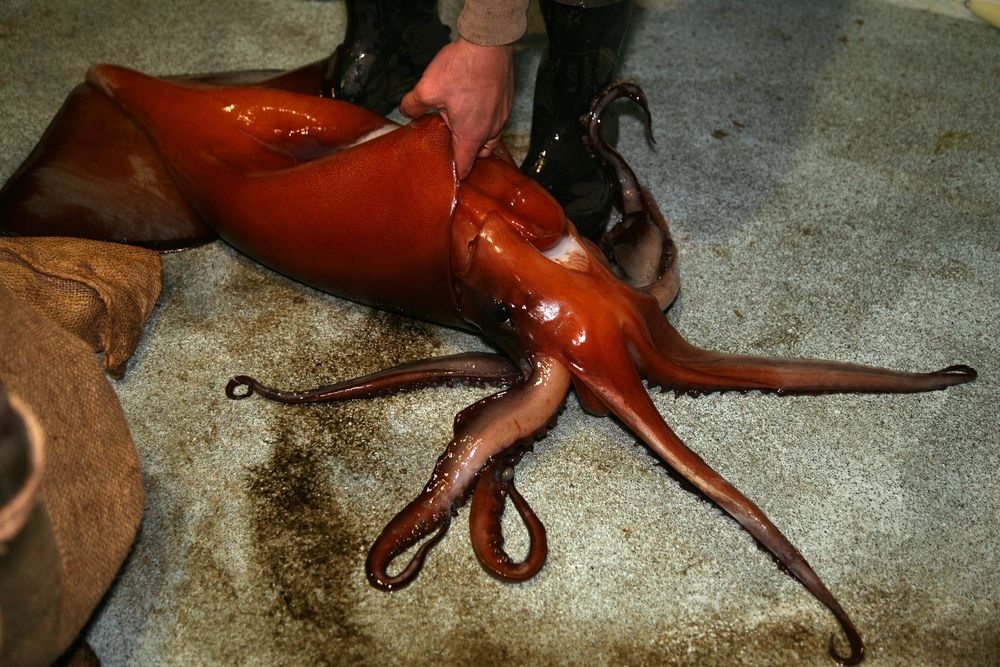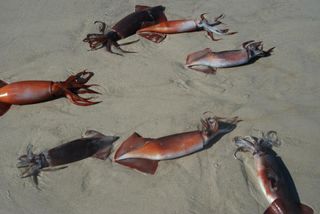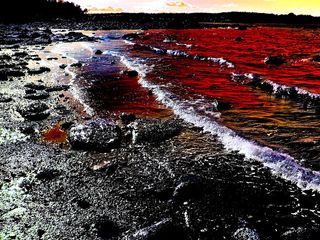
Thousands of jumbo squid have beached themselves on central California shores this week, committing mass "suicide." But despite decades of study into the phenomenon in which the squid essentially fling themselves onto shore, the cause of these mass beachings have been a mystery.
But a few intriguing clues suggest poisonous algae that form so-called red tides may be intoxicating the Humboldt squid and causing the disoriented animals to swim ashore in Monterey Bay, said William Gilly, a marine biologist at Stanford University's Hopkins Marine Station in Pacific Grove, Calif.
Each of the strandings has corresponded to a red tide, in which algae bloom and release an extremely potent brain toxin, Gilly said. This fall, the red tides have occurred every three weeks, around the same time as the squid beachings, he said. (The squid have been stranding in large numbers for years, with no known cause.)
"It's not exactly a smoking gun, but it's pretty circumstantial evidence that there is some link," Gilly told LiveScience. [See Photos of the Stranded Humboldt Squid]

Decades old mystery
For decades, beach lovers have reported bizarre mass strandings where throngs of Humboldt squid (Dosidicus gigas), also called jumbo squid, fling themselves ashore, said Hannah Rosen, a marine biology doctoral candidate at the Hopkins Marine Station.
"For some reason they just start swimming for the beach," Rosen told LiveScience. "They'll asphyxiate because they're out of the water too long. People have tried to throw them back in the water, and a lot of times the squid will just head right back for the beach."
Sign up for the Live Science daily newsletter now
Get the world’s most fascinating discoveries delivered straight to your inbox.
Before this, scientists in 2002 and 2006 noticed mass squid strandings from the Gulf of Mexico all the way to Alaska, Gilly said.
But the cause of the mass squid deaths was an enigma. The strandings seem to happen whenever schools of squid invade new territory, leading some to suggest the creatures simply get lost and don't realize they are out of the water until it is too late. The squid washing ashore are juvenile size, about 1 foot (0.3 meters) long, and hadn't been traveled to Monterey Bay before this fall. This season's stranding, which started Oct. 9, happened around the time Humboldt squid entered the bay.
Deadly algae
Other scientists have proposed that red tides that release a lethal toxin called domoic acid may be intoxicating the squid and disorienting them. But when researchers tested the stranded squid for domoic acid, they found only trace amounts of the chemical, Gilly said.

The poisonous chemical mimics a brain chemical called glutamate in mammals, though domoic acid is 10,000 times more potent than glutamate. The similar structure means domoic acid can bind to glutamate receptors on neurons. In turn, the receptor opens channels that let calcium into the cell. At high levels the poison causes brain cells to go haywire and fire like crazy, so much that they fill up with calcium, burst and die, Gilly said. [10 Weird Facts About the Brain]
Humans who eat shellfish contaminated with this red-tide toxin get amnesic shellfish poisoning, because the toxin destroys their brain's memory center called the hippocampus. Sea lions that eat similarly poisoned anchovies or krill go into seizures or become disoriented and behave bizarrely.
However, no one has tested the effects of lower levels of the chemical on squid.
Potential cause?
But new evidence points to the red tide as at least one cause of the mass strandings. While most sea life follows daily tidal or lunar cycles, the mass deaths seem to be happening every three weeks. That led one of Gilly's graduate students, R. Russell Williams, to see if something in the environment was leading them astray.
"He was fixated in finding some kind of environmental signal," Gilly said.
Russell found that red tides occurred every three weeks, around the same time as the squid strandings, suggesting a link, Gilly said.
While past researchers have only found trace levels of the toxic red-tide chemical in stranded squid, low doses of domoic could essentially be making the squid drunk. Combined with navigating unfamiliar waters, that could cause the mass die-offs.
"They could be tipped over the edge by something like domoic acid that might cloud their judgment," Gilly said.
This isn't the first time Gilly and his colleagues have been led on a CSI-like hunt for Humboldt squid. In 2011, they figured out why the elusive jumbo squid left their usual feeding grounds off the Baja California coast in the winter of 2009 to 2010. Apparently, the squid had moved north, following their prey, small, bioluminescent fish called lantern fish, which had also moved north due to El Niño weather patterns.
Follow LiveScience on Twitter @livescience. We're also on Facebook & Google+.

Tia is the managing editor and was previously a senior writer for Live Science. Her work has appeared in Scientific American, Wired.com and other outlets. She holds a master's degree in bioengineering from the University of Washington, a graduate certificate in science writing from UC Santa Cruz and a bachelor's degree in mechanical engineering from the University of Texas at Austin. Tia was part of a team at the Milwaukee Journal Sentinel that published the Empty Cradles series on preterm births, which won multiple awards, including the 2012 Casey Medal for Meritorious Journalism.










